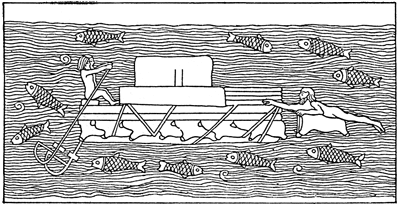Cultures > Assyria > Old Assyrian Kingdom
Old Assyrian Kingdom

Background
The city of Ashur was believed by some researchers to have been founded around 3,000 BC and recovered ruins date back to 1900 BC so the true origins of the city are open to interpretation. According to inscriptions found at the city the first written king was a man named Tudiya and his community was known to have lived in tents. It is known that the city of Ashur did belong for periods to the Akkadian Empire. This suggests in theme with the continued migration of Semitic nomads during this period that they were probably a wandering tribe that settled down. At its early origins the "city" was probably more of a tent city rather than an urban center. This does not mean that the early people of Ashur were any less advanced as their trading network suggests a sophisticated communication network.
One of the earliest and most mysterious kings is a man named Sargon I (1920-1881 BC) who fortified the city of Ashur and little else is known about him. He may have adopted the namesake of Sargon the Great which meant he may not have been a legitimate king and may have seized the throne. The next clearly documented event in Assyrian history is when king Erishum I built the Temple of Ashur around 1900-1905 BC. This is the ruins that have been recovered and what most historians give as the founding date for the city. However, this does not make any sense as in order to build a structure of this magnitude it requires planning, gathering of materials and construction.
This does not happen overnight and suggests and already existing social structure and habitation. The reason we have no evidence for their habitation is they most likely used biodegradable natural resources in the construction of their domiciles. Im sure if you dug deep and wide enough you would recover the trash pits from these early settlements. Again, one of the major barriers to doing any sort of modern excavation in the Middle East is the fact you would be doing so right during a real life Call of Duty game. This is not feasible for most researchers so they focus on other projects.
Trade Networks
The city of Ashur was able to become very wealthy due to its extensive trading network with the ancient city of Kültepe also known as Karum Kanesh. This wealth provided the city of Ashur with the means to expand its borders and eventually create an empire. From Asia Minor the Hittites the people of Ashur were able to acquire plenty of raw materials otherwise unavailable in the Mesopotamian region. They were able to perfect the trade of iron-working and this would prove to be a great military advantage in conquering the otherwise bronze and copper equipped soldiers of the day.

Assyrian Kelek Raft Relief
Despite its growing wealth and new influx of technology and resources there were still many competitors in the region. While the city of Ashur held dominance in northern Mesopotamia, the Hittites to the north were much larger than them and there was a growing presence of Amorites in the south that would eventually form the civilization known as Babylonia in the wake of the Sumerians.
Amorite Threat
Noting this growing Amorite presence in Babylonia, king Shamshi-Adad I who ruled from 1813 to 1791 BC began a campaign to drive the Amorites from the surrounding territory and reinforce his claims over the fledgling Assyrian Empire. He was successful and claimed Ashur as the capital city of Assyria. While they were expelled from the surrounding area, most of the Amorites took refuge in the growing city of Babylon to the southwest. Under the rule of Shamshi-Adad I the civilization of Assyria would expand to occupy the cities of Harran, Mari, Shubat Enlil, Ekallatum, and Eshunna.
Around the death of king Shamshi-Adad I, Hammurabi would ascend to the throne in Babylon and conquer Assyria. However, Babylonian domination over Assyria would only last until the death of Hammurabi in 1750 BC. Most of the first Babylonian Empire fell apart after his death, with each city-state reasserting their sovereignty over their territory. It appears that civil war broke out all through the city of Ashur with competing parties attempting to claim the throne.
It appears anarchy reigned for over twenty years until the Assyrian king Adasi II was able to regain control in 1726 BC and ruled until 1691 BC. While Adasi was able to secure the stability of Ashur and its surrounding territory, neither he nor his successors was able to expand the borders of the empire itself. Most of the rulers mentioned during this period do not have specific dates of rule, and most are brief at that.
Middle Assyrian Kingdom
Neo-Assyria Empire
